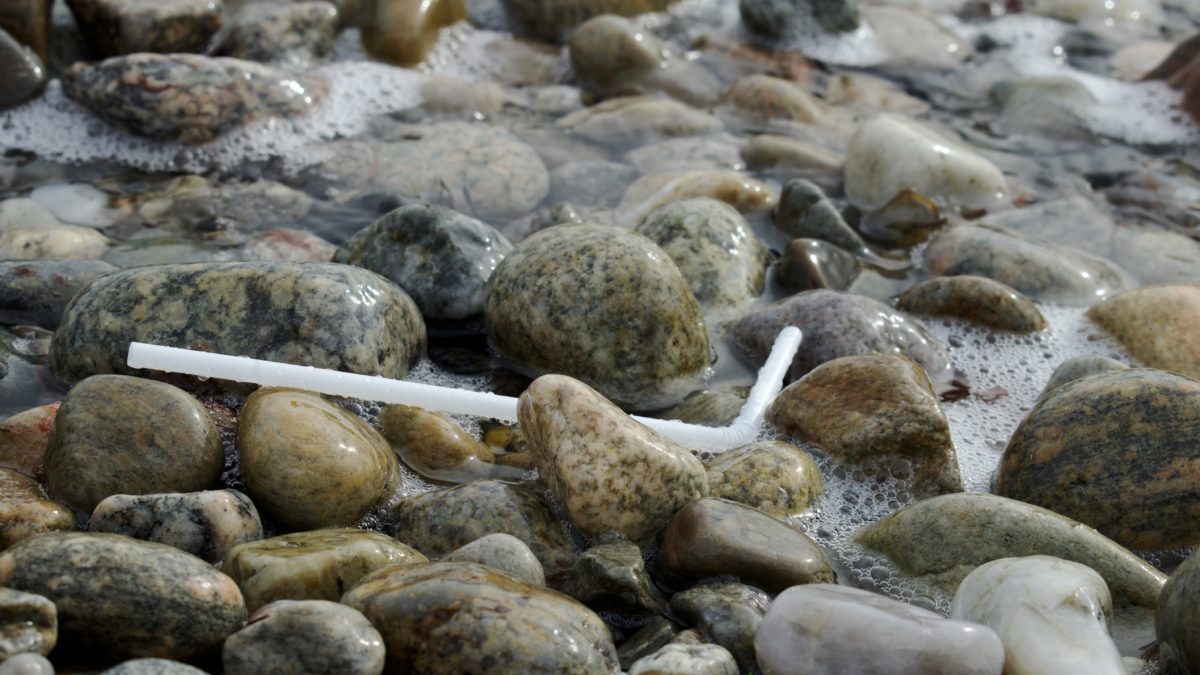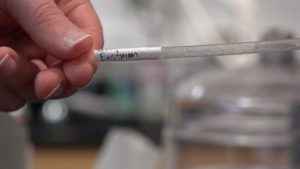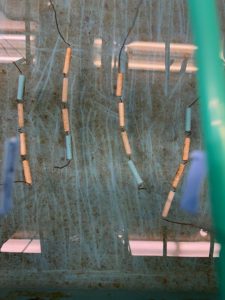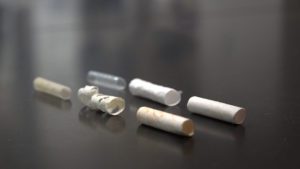Some Plastic Straws Degrade Quicker Than Others, New Study Shows
 Straws are one of the most commonly found sources of marine litter. Researchers say we lack a firm understanding of how long plastics last in the ocean, but that science supports moving away from using the material. (Photo by: Bryan James/©Woods Hole Oceanographic Institution)
Straws are one of the most commonly found sources of marine litter. Researchers say we lack a firm understanding of how long plastics last in the ocean, but that science supports moving away from using the material. (Photo by: Bryan James/©Woods Hole Oceanographic Institution) January 30, 2024
WHOI researchers determine lifetimes of commercial drinking straws in the coastal ocean and develop a prototype bioplastic straw that degrades even faster than paper
Woods Hole, MA — Straws are one of the most common plastic waste products found on coastlines. As more and more plastic products are being produced, consumed, and disposed of, scientists and manufacturers are developing alternative materials that work equally as well, and don’t contribute to persistent plastic pollution in the environment.
But not all plastics are created the same—different manufacturers have different formulations of base polymers—such as polylactic acid (PLA) and polypropylene (PP)—and chemical additives. That means different plastic formulations behave differently in the environment and break down in the ocean at different rates. There are new materials out in the market that move away from petroleum-derived products—like cellulose diacetate (CDA), a polymer derived from wood pulp that is widely used in consumer goods—and Woods Hole Oceanographic Institution (WHOI) scientists have been working to quantify the environmental lifetimes of a wide range of plastic goods to answer the unresolved question, how long do straws last in the ocean?

This straw is made of prototype material cellulose diacetate. The new study shows, this material breaks down even faster than paper in the environment when foamed. (Photo by: Rachel Mann/©Woods Hole Oceanographic Institution)
In a new paper published in ACS Sustainable Chemistry & Engineering, WHOI scientists Collin Ward, Bryan James, Chris Reddy, and Yanchen Sun put different types of plastics and paper drinking straws head-to-head to see which degrade the fastest in the coastal ocean. They partnered with scientists from bioplastic manufacturing company Eastman, who provided funding, contributed as coauthors, and supplied materials for the study.
“We lack a firm understanding of how long plastics last in the ocean, so we've been designing methods to measure how fast these materials degrade,” Ward said. “It turns out, in this case, there are some bioplastic straws that actually degrade fairly quickly, which is good news.”
Their approach involved suspending eight different types of straws in a tank of continuously flowing seawater from Martha’s Vineyard Sound, Massachusetts. This method also controlled the temperature, light exposure, and other environmental variables to mimic the natural marine environment. All straws were monitored for signs of degradation over 16 weeks, and the microbial communities growing on the straws were characterized.
“My interest has been to understand the fate, persistence, and toxicity of plastic and how we can use that information to design next-generation materials that are better for people and the planet,” James said. “We have the unique capability where we can bring the environment of the ocean on land in our tanks at the environmental systems laboratory. It gives us a very controlled environment with natural seawater.”
They tested straws made of CDA, polyhydroxyalkanoates (PHA), paper, PLA, and PP. In the weeks the straws were submerged in the tanks, the CDA, PHA, and paper straws degraded by up to 50%, projecting environmental lifetimes of 10-20 months in the coastal ocean. The PLA and PP straws showed no measurable signs of degradation.
The scientists then compared two straws made from CDA—one a solid and the other a foam, both provided by Eastman. The straw made from foamed CDA was a prototype to see if increasing the surface area would accelerate break down. They found that the degradation rate of the foam straw was 184% faster than its solid counterpart, resulting in a shorter projected environmental lifetime than the paper straws.
“The unique aspects of this foam straw are that it's able to have a shorter expected lifetime than the paper straws but retain the properties that you enjoy of a plastic or a bioplastic straw,” James said, making it a promising alternative to conventional plastic straws compared to paper straws, which degrade quickly in the ocean but sour user experience by getting soggy, according to the authors.

Degradation of straws made from different types of materials were observed for 16 weeks at WHOI's Environmental Systems Lab. The tanks the straws were kept in had a continuous flow of ocean water from Martha's Vineyard Sound. (Photo by: Bryan James/©Woods Hole Oceanographic Institution)
“This study can be immensely valuable for straw manufacturers by providing informed and transparent data when selecting a material for straws. Even more, it provides reassurance that CDA-based straws won’t add to the persistent plastic pollution, while also demonstrating straw manufacturers’ commitment to offering a sustainable product that reduces risk to marine life,” said Jeff Carbeck, Eastman’s Vice President of Corporate Innovation.
Science supports a push away from conventional plastic material. Plastic pollution causes harm to humans and ecosystems and the plastic industry is a large-scale contributor to climate change, accounting for roughly 4 to 5% of all greenhouse gas emissions across their lifecycle. With plastic waste becoming ubiquitous in the global ocean and marine food chain over the past 50 years, it’s important to identify new materials that are sustainably sourced, contribute to the shift from a linear to a circular economy, and break down if they incidentally leak into the environment.
“While some push to shift away from plastics, the reality is that plastics are here to stay. We're trying to accept the fact that these materials are going to be used by consumers, and then we can work with companies to minimize the impacts of them should they leak into the environment,” Ward said.
“We recognize the importance of testing, validating and understanding the marine degradation of our CDA based products, but lacked the necessary resources,” Carbeck said. “Knowing that WHOI possessed the expertise and facilities, we engaged in a collaborative effort to address this challenge. This partnership showcases the power of industry-academia collaboration in advancing shared goals and making a positive impact.”

Different types of straws after being continuously run over by ocean water for 16 weeks. (Photo by: Rachel Mann/©Woods Hole Oceanographic Institution)
The research team also found that the microbial communities of the straws that degraded were unique to each straw material. However, the microbial communities on both non-degrading straws were the same despite having vastly different chemical structures. This provided further evidence that the native microbes were degrading the biodegradable straws, whereas the non-biodegradable straws likely persist in the ocean.
“Our understanding of the impacts of plastic pollution on ocean health are really uncertain, and a lot of this boils down to not know the long-term fates of these materials,” Ward said. He and the rest of the research team plan to continue measuring the degradability of plastic materials, with the hope of guiding where the industry goes next.
“There are a lot of advantages of partnering with material manufacturers, including access to analytical facilities, and knowledge about and access to their materials that you don't get if you work in your own silo,” Ward said. “We’re trying to optimize their products for degradation in the environment and ultimately the good of the planet.”
Authors:
Bryan D. James,*,1 Yanchen Sun,1 Mounir Izallalen,2 Sharmistha Mazumder,2 Steve T. Perri,2 Brian Edwards,2 Jos de Wit,2 Christopher M. Reddy,1 Collin P. Ward*,1
Affiliations:
1 Department of Marine Chemistry and Geochemistry, Woods Hole Oceanographic Institution, Woods Hole, MA, USA 02543
2 Eastman, Kingsport, TN, USA 37662
About Woods Hole Oceanographic Institution
The Woods Hole Oceanographic Institution (WHOI) is a private, non-profit organization on Cape Cod, Massachusetts, dedicated to marine research, engineering, and higher education. Established in 1930, its primary mission is to understand the ocean and its interaction with the Earth as a whole, and to communicate an understanding of the ocean’s role in the changing global environment. WHOI’s pioneering discoveries stem from an ideal combination of science and engineering—one that has made it one of the most trusted and technically advanced leaders in basic and applied ocean research and exploration anywhere. WHOI is known for its multidisciplinary approach, superior ship operations, and unparalleled deep-sea robotics capabilities. We play a leading role in ocean observation and operate the most extensive suite of data-gathering platforms in the world. Top scientists, engineers, and students collaborate on more than 800 concurrent projects worldwide—both above and below the waves—pushing the boundaries of knowledge and possibility. For more information, please visit www.whoi.edu
Key Takeaways
- Not all plastics are created the same, and some last longer in the ocean than others. WHOI scientists have been working for years to quantify the environmental lifetimes of a wide range of plastic goods to see which have the shortest and longest lifespans in the ocean. To determine what plastics persist in the ocean, the team tests different products in large tanks that recreate the natural ocean environment. They focused on drinking straws first, as they are one of the most prevalent forms of plastic waste found in beach cleanups.
- The authors found that straws made from cellulose diacetate (CDA), polyhydroxyalkanoates (PHA), and paper degraded by up to 50% in 16 weeks. They all had unique microbial communities that helped break down the material.
- A prototype straw from Eastman, made of foamed CDA, degraded more quickly than the solid, meaning that altering the surface area of the straw can speed up the degradation process.
- Science supports a shift away from persistent plastics—making it even more important to ensure new materials break down if they leak into the environment and don’t further pollute the ocean.
